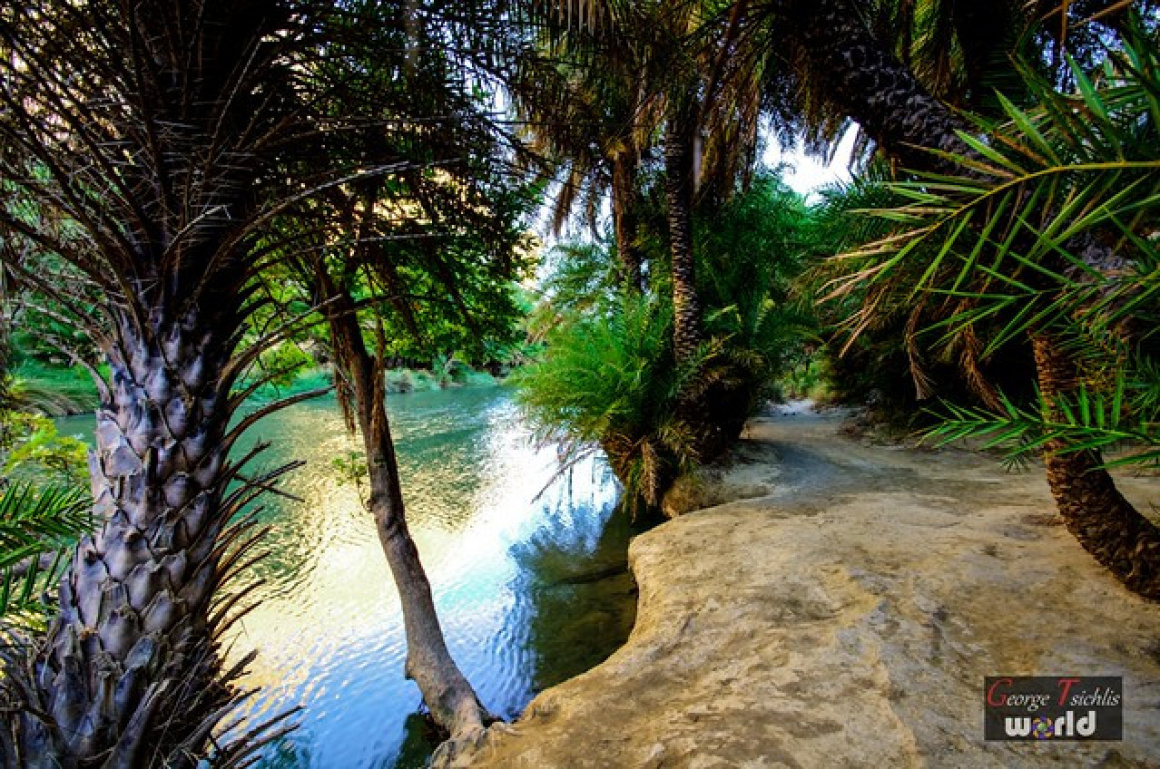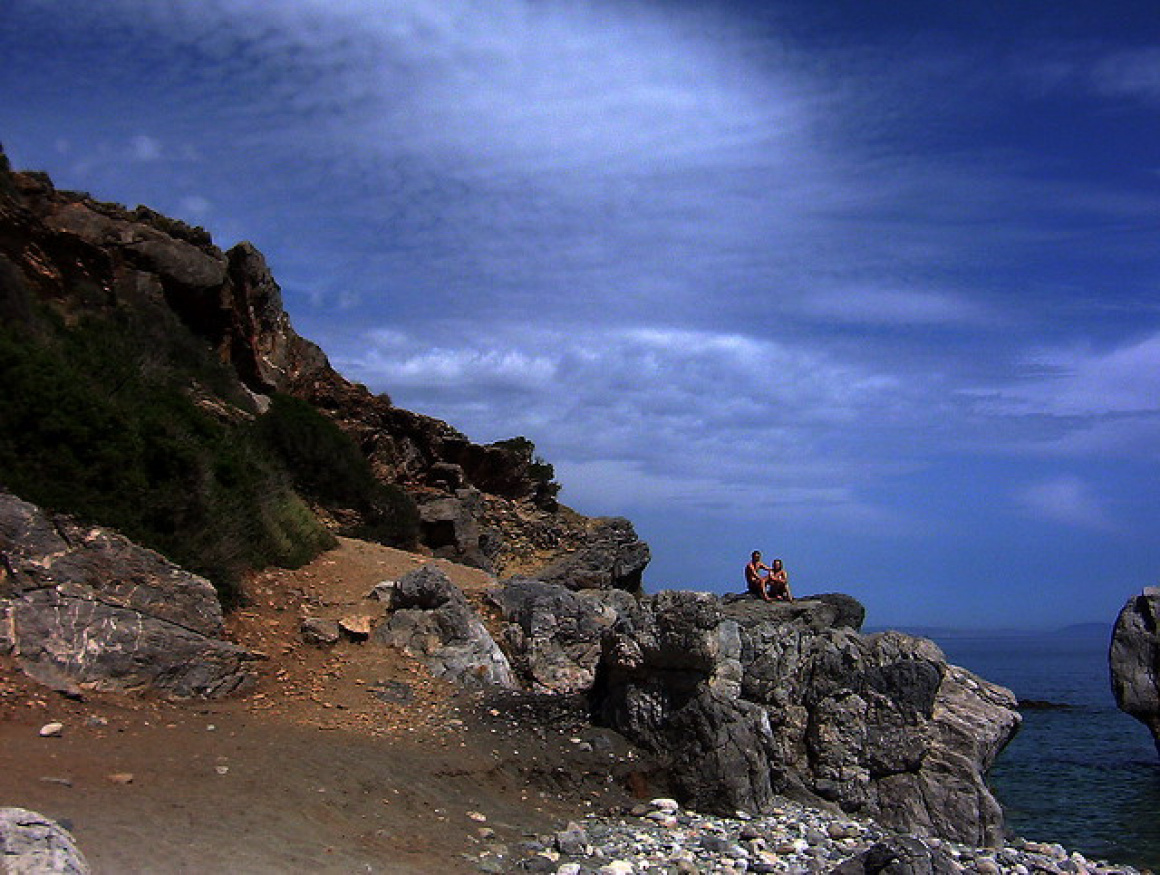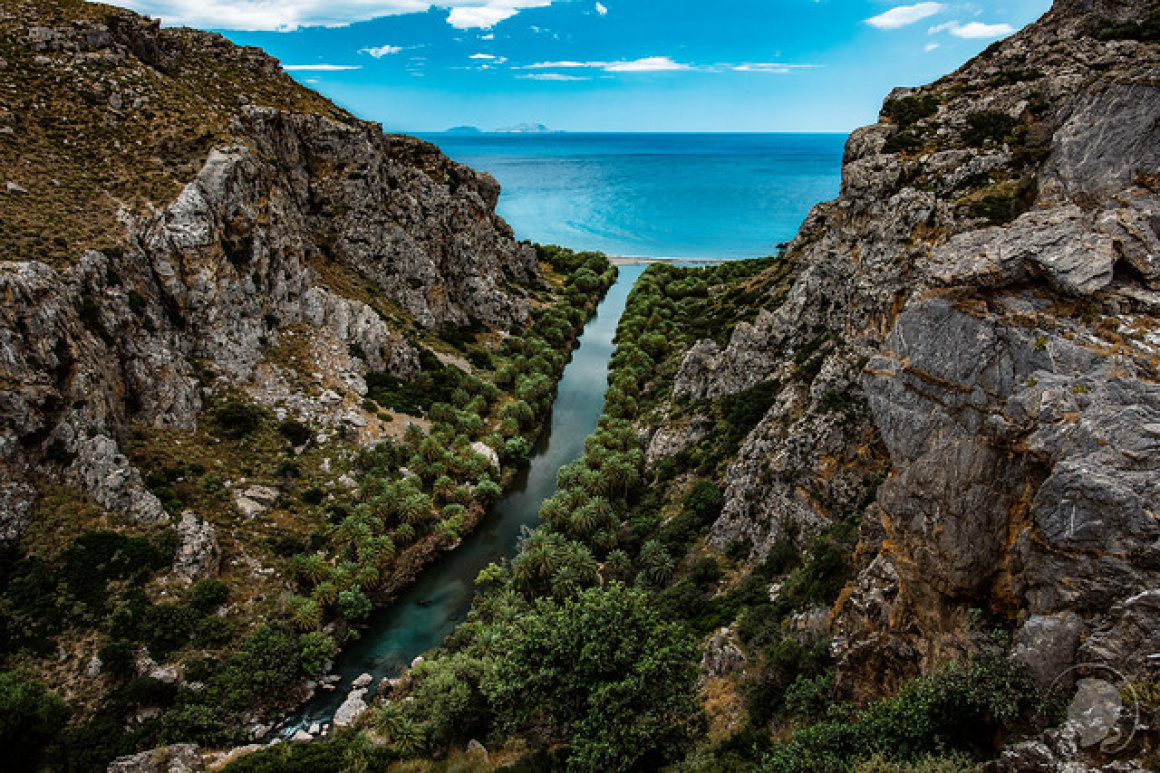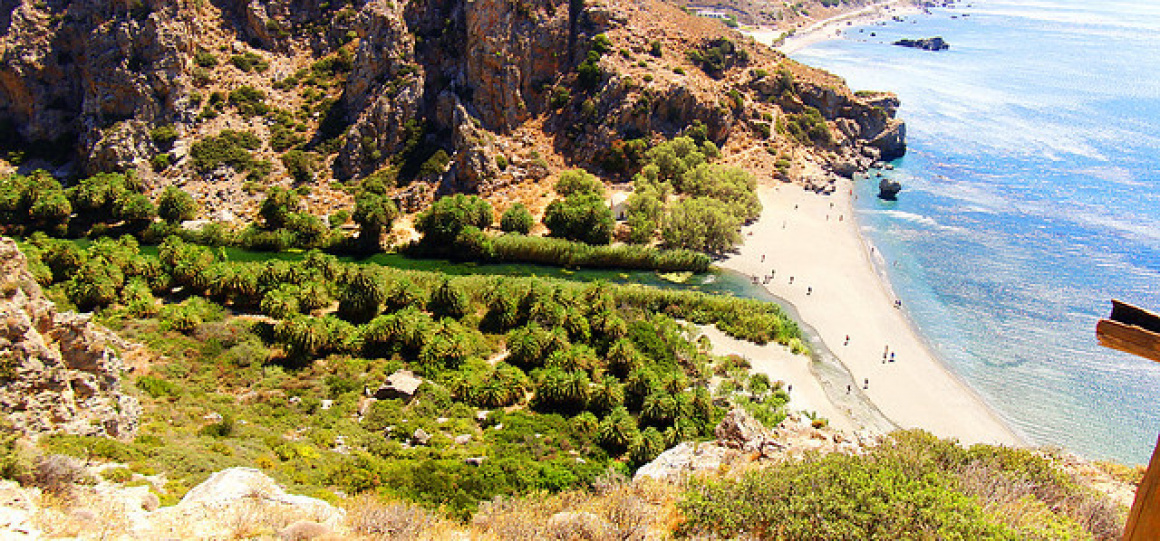Introduction
Crete is an island of surprises, and Preveli Beach is surely one of its most delightful. Tucked away on the island's rugged southern coast, Preveli is where a fresh mountain river meets the Libyan Sea, and tall palm trees line the riverbanks creating a scene straight out of a tropical adventure film. Many visitors describe the first glimpse of Preveli as unforgettable: after hiking down a winding footpath along a cliff, the view suddenly unfolds – below you lies a ribbon of green palm forest hugging a river lagoon, which spills into a turquoise cove, all framed by dramatic arid cliffs. The juxtaposition of the arid surroundings with the lush greenery of the river oasis is striking. It's no wonder Preveli is often called “Palm Beach,” second only to Vai in fame (Crete's other palm oasis). Beyond its natural beauty, Preveli is imbued with a sense of tranquility and a touch of adventure – reaching it requires a little effort, which keeps it feeling just remote enough. As you descend toward the sand, you might feel like an explorer discovering a hidden paradise that somehow still has a secret vibe despite its popularity.

 'Preveli palm beach' - Attribution: gatsishot
'Preveli palm beach' - Attribution: gatsishotNature's Resilience: The Palm Forest and River
Preveli's defining feature is its palm forest, consisting of the native Cretan date palm (Phoenix theophrasti, the same species as at Vai). These palms line both sides of the Megalos Potamos river that flows through the Kourtaliotiko Gorge and reaches the sea here. Walking under their canopy provides cool relief on a hot day. The river forms a small lagoon at the beach, then trickles into the sea. Adventurous visitors love to wade, swim, or even paddle a bit up the river. Upstream a few hundred meters, the river forms pools and ponds beneath the palms. You can swim in these freshwater pools (the water is refreshingly cool, even in summer) and find natural little “jacuzzis” where the current bubbles over rocks.
The palm grove feels like something from North Africa or the Middle East transplanted to Crete. In fact, local legend ties Preveli to Odysseus: it's said that Odysseus found refuge here after the Trojan War, and that he planted the first palm seeds (some versions even claim the palms sprang from date seeds in his provisions). Whether myth or not, the area does have an otherworldly quality – you could easily imagine Bedouins watering their camels by the river in ancient times.
In August 2010, a devastating event put Preveli's natural resilience to the test. A wildfire swept through the area, and much of the palm forest went up in flames. The sight was heartbreaking; charred palm trunks and ash covered what was once an oasis. But incredibly, the palms demonstrated a miraculous recovery. By the next spring, green shoots were sprouting from many of the burned palms, and within a couple of years the forest was largely regenerated. It turns out the Cretan date palm has a natural resistance: its root system and core can survive fire and regrow. Today, you might notice some palms with blackened bark – silent witnesses to that fire – but with full crowns of new fronds above. Interpretive signs by the local forestry service note this rapid natural rebirth as a marvel of Preveli.
Flora and fauna thrive around the river. Oleander shrubs with pink blossoms dot the riverbanks. You might see dragonflies skimming the water and crabs scuttling among the stones. If you venture a little up the river trail, you'll find spots where sunlight filters through palm fronds onto clear water, creating a dappled light show. In the heat of midday, small groups of hikers find refuge here, some even picnicking on rocks mid-stream, their feet dipped in the cool flow.
The beach itself is a mix of coarse sand and pebbles. On the west side, a rocky outcrop extends into the sea. One distinctive rock sitting just offshore is shaped uncannily like a giant heart when viewed from certain angles – locals call it the Stone of Lovers. It makes a fun photo op for couples (and a convenient meeting point on the beach).

 'Preveli Beach' - Attribution: Dada Iliescu
'Preveli Beach' - Attribution: Dada IliescuWhat to Do at Preveli Beach
Most visitors come for a mix of relaxation and light adventure. Preveli offers both in equal measure:
Reaching Preveli: Getting There is Part of the Adventure
One reason Preveli retains a wild charm is that it's not directly accessible by car. You have two main options to reach it:
Hike down from the parking area:
This is the most popular way for independent travelers. You drive to the Preveli Beach parking lot, located on the eastern side of the beach on a cliff. It's accessible via asphalt road through the village of Drimiskiano Amudi or via the Kourtaliotiko Gorge road. The parking lot (often free, sometimes a small fee in peak season) has a snack canteen and usually a lot of goats lazing around. From here, you take a steep footpath down. Expect about 15-20 minutes of descending via a combination of carved steps and rocky path. There are handrails in parts, but it's still a mini hike. Wear proper shoes (flip-flops can make it unpleasant or risky). The way down is scenic – views galore – and you'll likely be energetic. Keep in mind, the way back up is a fairly strenuous climb of some 300+ steps and slopes. Many a traveler has been humbled by the Preveli climb in the heat of late day. So bring water, and take your time ascending (there are a couple of shaded rest points). This route is not ideal for anyone with mobility issues or very young kids, but it is doable for most people in reasonable shape.

 'Crete - Preveli Palm Beach - No. 1' - Attribution: Lichtrebell
'Crete - Preveli Palm Beach - No. 1' - Attribution: LichtrebellBy boat from Plakias or Agia Galini:
In summer, boat taxis and tour boats run to Preveli. From Plakias (the nearest tourist town, about 10km west), small boats shuttle to Preveli a few times a day, usually morning departures with afternoon returns. It's a relaxing 30-minute ride along the stunning south coast, and you get to approach Preveli from the water – the palms and beach suddenly reveal themselves as the boat rounds a headland. From the boat drop-off point on the west side of the beach, you step right ashore with no hiking needed. Boats also come from Agia Galini (which is further east) but often that's a longer excursion stopping at Preveli as one of multiple destinations. Check local schedules; boats are weather-dependent (if the sea is rough, they won't run, though that's rare in summer mornings).
Each option has its perks: hiking gives you the panoramic viewpoint and flexibility of timing; boating spares you the climb and offers a cool coastal cruise. Some savvy travelers do a combo – hike down early, enjoy the beach, then catch an afternoon boat to Plakias and bus/taxi back to your car later, or vice versa.
Driving note: If you're exploring by car, you might also visit the nearby historic Preveli Monastery either before or after your beach time. It's just a 10-minute drive from the parking area and sits atop a gorge with glorious sea views. Given the beach's remote location, many make a full day: monastery in the morning, beach by midday, then perhaps dinner in Plakias.
Practical Tips
Facilities: Preveli is intentionally underdeveloped. At the beach itself, don't count on more than maybe one seasonal cantina (in some summers, a simple shack sells cold drinks and sandwiches on the beach, other years nothing). There are no sunbed rentals in recent years (to protect the environment), and crucially no public toilets at the beach. The nearest toilets are by the parking lot way up top or on the excursion boats. So be prepared for rustic conditions; whatever you carry in (supplies, food, etc.), also carry out all trash. The palm oasis needs our care – littering here is sacrilege.
Bring: plenty of water, sunscreen (the sun reflects off water and sand, easy to burn), good shoes for the hike and possibly for river walking (sandals that can get wet or old sneakers), and maybe snorkel gear if you enjoy that. If you have a dry bag, it's useful for keeping things dry if you decide to swim up the river with your backpack.
Crowds: In July and August, Preveli can get busy from late morning to late afternoon, especially when multiple tour boats arrive. The beach is fairly large, but the prime spots (under the few tamarisk trees, or near the river) can fill up. If you want solitude, try to come before 10 AM or after 4 PM. Many visitors on boats leave by 5 PM. After that, a wonderful calm returns – just the remaining few adventurers and the sound of cicadas.
No Camping: While it was once common for hippies and backpackers to camp out under the palms, it's now forbidden by law (the 2010 fire reinforced the need for strict protection). Rangers or police do check, and campers will be fined and evicted. It's tempting to overnight in such beauty, but it's not allowed – instead, consider staying in nearby Plakias or the youth hostel up the hill (there is a Youth Hostel called “Youth Hostel Preveli” near the upper car park, a basic but beautifully located hostel).
Respect the Environment: The area is a protected Natura 2000 site. Don't make fires, don't disturb wildlife, and try not to trample young palm shoots near the river. Also, the palms have recovered from fire but could be threatened by a destructive palm beetle plague that affects such trees – another reason to minimize human impact.
The Monastery Connection and War History
Overlooking Preveli beach from the hills to the west is the historic Preveli Monastery, after which the beach is named. The monastery actually consists of two complexes: the Lower Monastery (now ruins) and the Upper Monastery of Preveli (still active). This monastery has a rich history entwined with Crete's struggles for freedom. In the 19th century, it was a refuge for rebels fighting Ottoman occupation. And in World War II, Preveli Monastery earned renown when the monks, led by Abbot Agathangelos, harbored Allied soldiers (British, Australian, New Zealand) who were hiding from the Germans after the Battle of Crete. In 1941, these soldiers were gathered and evacuated by a British submarine from Preveli Beach itself! More than 150 men escaped thanks to this effort. A daring second pick-up was attempted a month later. The Nazis eventually discovered the monastery's role; in retaliation they razed part of it and punished the monks, with some monks executed or sent to camps. This WWII story is legendary – there's a memorial at the monastery and even one in faraway Australia. The cove where the evacuations occurred is sometimes referred to as Limni Beach (just east of Preveli beach) – you can actually see it from the trail down (it's the next bay over, smaller and rockier).

 'Preveli Monastery, Crete, Greece' - Attribution: Neil Mair Photography
'Preveli Monastery, Crete, Greece' - Attribution: Neil Mair PhotographyKnowing this history adds depth to a visit. As you stand on Preveli's sand, you're also on a site of wartime bravery. Perhaps on quiet days one can imagine the tense nights of 1941, with Allied soldiers silently wading to a submarine periscope-deep in the dark bay, and monks praying for their safe passage.
Today, Preveli Monastery welcomes visitors (dress modestly: shoulders and knees covered). It houses a small museum of icons and the famous Cross of Preveli, a large silver cross believed to have miraculous properties. Many visitors combine the monastery visit with the beach in one day, getting both cultural insight and natural beauty.
Recommended Accommodation Nearby
Preveli itself has no accommodations, but just 20 minutes drive west is Plakias, a laid-back beach town that's an ideal base for exploring south Rethymno (including Preveli). In Plakias, you'll find everything from budget studios to comfortable hotels:
Alianthos Garden Hotel – A popular family-run hotel right across from Plakias beach, known for friendly service and a good breakfast. It's central, making it easy to stroll to restaurants in the evening.
Plakias Suites – If you prefer self-catering luxury, these modern, spacious apartments at the quiet end of Plakias beach are highly rated. They literally step out onto the sand and offer kitchenettes, great for families or couples who want independence.
Kalypso Cretan Village Resort & Spa – For something more resort-like (and with a unique location), this hotel is perched on the cliffs just north of Plakias in the Karavos area. It has its own little fjord-like coves and is about a 10-minute drive from Preveli's parking. Its setting is dramatic, and it offers a pool and spa. It's a bit secluded – great if you want a retreat vibe.
If you'd rather position yourself east of Preveli, the village of Agia Galini (about 45 min east by car) is charming with boutique hotels and guesthouses climbing a hillside – a good stop if you plan to explore more of the south coast.
Insider Tips
Try some local food after your beach day. At the top of the cliffs near the parking is the taverna Gefyra Taverna (by the old stone Preveli bridge on the main road) – a rustic spot famous for goat stew and river trout, connecting you to the flavors of the region.
If you're an early riser, consider catching sunrise at Preveli. The orientation is actually better for sunrise than sunset. You'd need to hike down in semi-dark (headlamp recommended) but being on the beach at dawn, with the first rays lighting the palm gorge, is a soul-soothing experience – likely just you and maybe a lone fisherman.
Preveli is also known in hippie lore: after Matala's caves were cleared in the 1970s, many hippies relocated to Preveli's palm grove for a while. You might still meet older travelers who reminisce about those free-love days under the palms. That era is gone, but a bit of the bohemian spirit lingers.
If you love Preveli and want more of that vibe without repetition, check out Vai Palm Beach on the far east of Crete. It's larger and more developed than Preveli, but also boasts an impressive palm forest and stunning beach – sort of Preveli's eastern cousin.
In sum, Preveli Palm Beach is a must-see for nature lovers and those seeking a blend of relaxation, mild adventure, and history. It's one of those places where you can lounge on a beach towel and gaze at palm fronds above, then a short while later be splashing in a cool river beneath those same palms, and finally finish the day on a monastery terrace pondering the bravery of monks and soldiers. Few destinations pack so many different experiences into one cove. It's the essence of Crete's diversity in one beautiful package.
For more on Crete's unique beaches, see our guide to Vai Palm Beach – another palm paradise. History buffs might also enjoy our write-up on Arkadi Monastery, which, like Preveli's monastery, played a heroic role in Crete's past.

